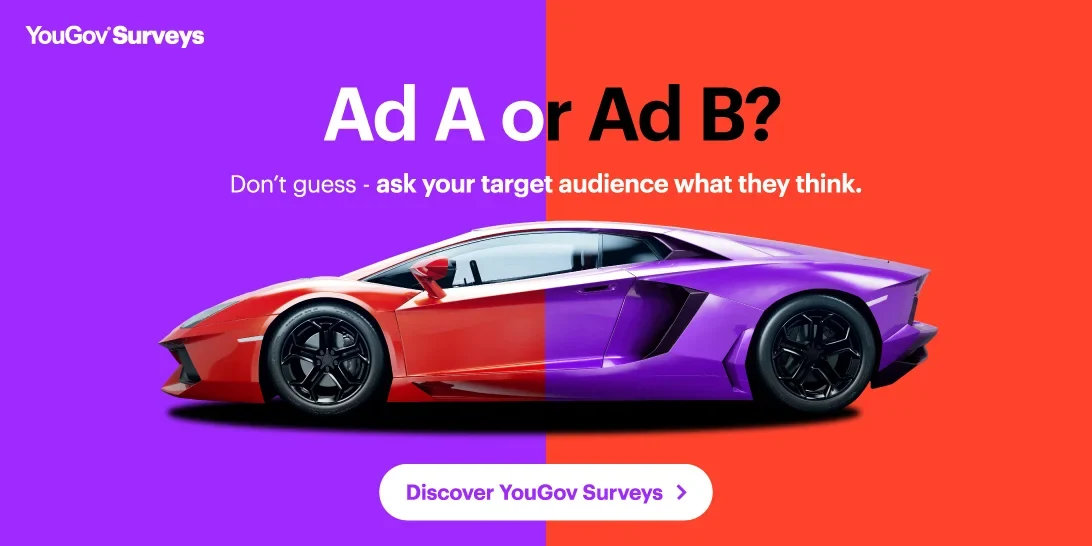
How to test marketing messaging & ad creative with your audience
Crafting the right marketing messaging is crucial for capturing the attention and interest of your target audience. However, determining the effectiveness of your messaging requires proper testing. How do you test ad creatives to know what will resonate best? How do you test messaging with target audience groups effectively?
This article will guide you through the process of testing your marketing messaging with your audience to ensure your communications resonate and engage in the most effective way possible.
It’s a clear process:
Define your objectives:
Before diving into testing, it's important to clearly define your objectives.
What specific aspects of your messaging do you want to assess? Is it the clarity, persuasiveness, or emotional appeal? Having well-defined objectives will help you design your testing approach more effectively.
Create variations:
Develop different versions of your marketing messaging to test, you will need at least two clear options.
Experiment with different headlines, taglines, value propositions, or calls to action. Ensure each variation reflects a specific aspect of your messaging that you wish to evaluate. Keep in mind that simplicity and clarity are essential to convey your message effectively, and always refer back to those objectives.
Identify your target audience:
Identify the specific segment of your target audience you want to test your messaging with. Consider factors like demographics, psychographics, and behaviors. This will ensure that your testing is conducted with the most relevant audience group for your marketing campaign.
You might want to test something broadly, with representative audiences of the entire population of multiple markets. You might want to go more niche, if your campaign or product has a very particular target audience. I.e. parents in a certain age bracket who live in the city and shop on the weekend.
Choose testing methods:
There are various methods to test marketing messaging. Here are a few popular ones
- Research surveys: Create a questionnaire to gather feedback on the different messaging variations. Use Likert scale questions (a question which is a five-point or seven-point scale, in which respondents can choose a negative, neutral or positive response to a statement) to measure the audience's perception of clarity, appeal, and relevance. An example of a Likert scale question: “How satisfied are you with the service you have received from [X brand]” with five options ranging from “Highly satisfied” to “Highly dissatisfied”.
Open-ended questions (a question that cannot be answered with a “yes” or “no” or static response) can provide additional insights and suggestions for improvement. For example, “What did you think of today’s workshop?” or “What would you like to learn more about?”. These will yield qualitative examples and are non-leading questions that prompt a more organic response from your audience. - Focus groups: Organize interactive sessions with a small group of participants representing your target audience. Present each messaging variation and facilitate discussions to gather qualitative feedback, opinions, and reactions. Encourage participants to express their thoughts openly.
- A/B Testing: Utilize digital platforms to conduct A/B testing. Split your target audience into two groups and expose them to different messaging variations. Measure the response rates, click-through rates, conversions, or any other relevant metrics to determine which messaging performs better.

Gather and analyze data:
Collect all the data from your testing methods and analyze the results. Look for patterns, trends, and common feedback across the variations. Identify strengths and weaknesses of each messaging element and assess how well they align with your objectives, and whether your audience is being accounted for.
Iterate and refine:
Based on the feedback and data analysis, it’s now time to refine your messaging in a data-informed way. Incorporate the insights gained from testing and make necessary adjustments to enhance the effectiveness of your communication.
Consider both qualitative and quantitative feedback to ensure a well-rounded approach.
Re-test and validate:
After refining your messaging, conduct further testing to validate the changes. Use similar methods as before, but this time, focus on the areas you modified. This iterative process ensures continuous improvement and optimization of your marketing messaging.
Monitor performance:
Once your refined messaging is deployed in your marketing campaigns, closely monitor its performance. Measure key metrics, such as engagement rates, conversion rates, or brand recall, to assess the impact of your messaging on audience behavior. Use this data to inform your future messaging strategies, and make sure you take key learnings away from your research at all stages.
Why you should test your marketing messaging:
Testing marketing messaging with your target audience is essential for creating impactful and resonant communications. By defining objectives, creating variations, selecting appropriate testing methods, and analyzing the data, you can gain valuable insights to refine and optimize your messaging. Remember, testing is an iterative process, and ongoing evaluation will lead to continuous improvement and better engagement with your audience.
How to test your marketing messaging with YouGov:
YouGov can help you conduct message, concept, ad and product testing across your consumer journey. Our range of solutions offer a service level that suits your needs, timeline and budget.
Create your own direct-to-consumer surveys with our rapid, self-service survey building platform. You can target your audience to get the rapid consumer feedback you need to test ideas and shape your strategy - available in GB & US.
Our researcher-supported Surveys solution allows you to develop successful products, campaigns and more by working alongside our expert research team for advice on robustly testing pricing models, creatives and concepts.
We also offer the option to target a specific point in the customer journey! Our templated testing research questionnaires help you track respondents as they move from brand awareness, through to purchase intent and loyalty, for accurate customer intelligence on your audience.
Whatever your need, we’ll help you get the answers you need from your target audience to inform your strategy. Increase ad and product effectiveness whilst maximising ROI with our advanced, templated approaches to testing.